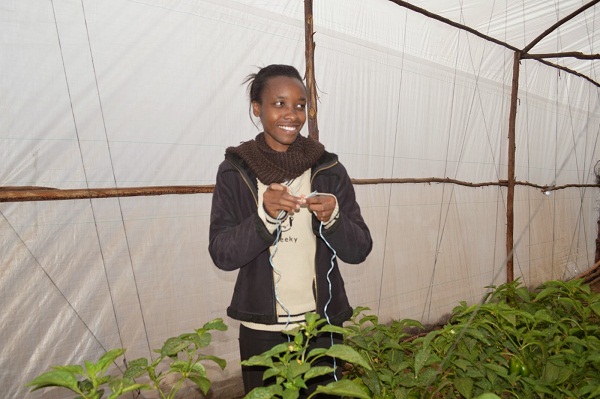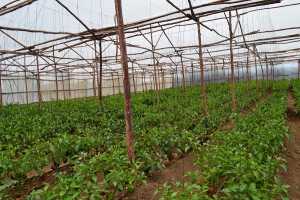Using the word only to describe a greenhouse is a gross understatement. Green houses are like infants; you’ve got to watch them all the time. Just yesterday I was in a meeting with a lady who said that her green house is in ICU. Her tomato crop had been attacked by blossom-end rot. The crop was drying so fast that she was panicking. Huge losses were staring her in the face.
In greenhouse business, a host of diseases, pathogens and insects can make you uproot your entire crop if either attacks. Nonetheless, I find the word only a befitting qualifier for a greenhouse when you are looking at Ksh. 10 Million return on investment in two years. Hence, you only need a greenhouse to become a millionaire.
Does having 10 million in the bank make you a millionaire? Well, we can talk about who is a millionaire another day. Today we talk about Linda Atambitsa, a 32 year-old microbiologist whose quest for a satisfying career landed her on a path to millions.
Linda’s motivation to get into agribusiness
Linda was until June 2013 a Quality Assurance Supervisor at a leading dairy processing company. However, she felt that her energy was not being fully utilized at the company and decided to quit a well-paying job to get on track with what she trained for at the university; medical microbiology.
“I got tired of writing reports and quit a job that most of my peers envied. I was earning over Ksh. 100,000 but I needed to get out. I trained to be a microbiologist and I want to practice it,” Linda explains.
Never quit a job unless you have a plan
Getting into a career in her area of expertise would take a bit of time and Linda needed a source of income as she sought the career of her dreams. She started plotting her exit plan from her job in December 2012.
Linda knew that she needed change in her career and she had to prepare for the ups and downs of that change. Before quitting her job she carefully analyzed investment ideas and finally settled for greenhouse farming. This was after interacting with John Maingi, the Director of Foods Africa Enterprise, whose story you can read here. Linda did a plant projection analysis on greenhouses and she loved the bottom line. In business, it is always about the profits.
Greenhouses are capital intensive
Despite the obvious profits from greenhouse farming, these paper houses are damn expensive to put up. Linda used up most of her savings to put up one green house on a quarter acre of land. She did not have land that was easily accessible to her. Farming is hands on and Linda knew that from the onset. She needed to lease land that she could easily access at any time. Fortunately, she found a piece of land in Ruiru. It cost her Ksh. 600,000 to lease land, put up the green house structure, get seedlings and fertilizer from Foods Africa Enterprises. This was a fair deal considering that Linda used cheap and easily material for the greenhouse.
Yellow and Red capsicums are Linda’s gold mine
A variety of high value crops can be grown in greenhouses: tomatoes, garlic, beetroot, cucumbers, chillies, eggplant and capsicums among others. Depending on the farmer’s focus and passion, each crop has its own pros and cons.
Linda found capsicums to be the best for her greenhouse project. They are ornamental vegetables that go for Kshs. 350 per kg in supermarkets and the export market is insatiable. Linda has a combination of yellow and red capsicums in her green house. She never has to worry about market glut or fluctuating market prices. She has a ready market thanks to her partnership with Foods Africa Enterprises. The company buys all her produce once it’s ready.
Agriculture demands patience
In April 2013, Linda’s green house project almost came to a halt. She had depleted her savings and she was about to give up. She was still in the construction stage of the green house. Luckily, she willed herself back on track and sought alternative ways to make a cheap green house. Today, her huge green house is the marvel of many.
Challenges are part of the business in commercial agriculture. When I met Linda for this interview, she was diagnosing a disease on her crop that was making leaves fold and flowers to fall off. The loss of a flower on a capsicum plant is the loss of a fruit. Linda tells me that she is lucky that her background in science helps her detect any changes on her crop. She is doubly lucky to have Foods Africa offer consultancy services for her farm. That is how her crop is still thriving despite the minor threats of diseases.
Linda’s advice
The sweetest moments in agribusiness are harvest time. Linda is currently pocketing an average of Ksh. 30,000 per week from her harvest. She planted her capsicum seedlings in August 2013 and it is already harvest time!
Linda however advises that young people getting into agribusiness should cultivate patience. Agribusiness is not an economic asprin for financial troubles. Just like any investment, it requires planning, adequate preparation and it is very risky.



